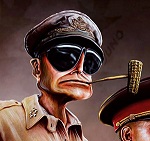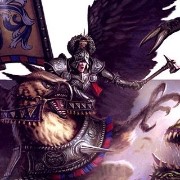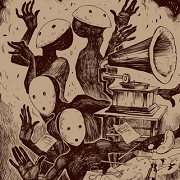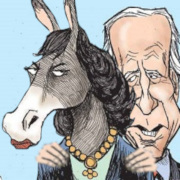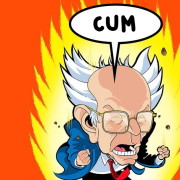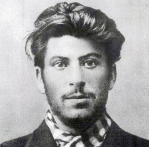(Thread IKs:
dead gay comedy forums)
|
Pener Kropoopkin posted:I'm starting to think this is actually a child. yeah the whole 'prospective whatever student' bit in their bio makes me think this is literally a teenager
|
|
|
|

|
| # ? May 25, 2024 22:18 |
|
Pener Kropoopkin posted:I'm starting to think this is actually a child. we need to bully the teens more
|
|
|
|
”wannabe shi’ite”
|
|
|
|
anyone who says “muh” instead of “my” gets a field trip to the parts of Siberia that are on fire
|
|
|
|
Tomboys are fash bait
|
|
|
|
gradenko_2000 posted:oh look they unprotected is this even kind of true? I’ve never heard it before
|
|
|
|
it's not true, their source for it is that the KPD opposed the SPD, and this is interpreted as 'supporting the Nazis' like this is what they keep linking to back up "the German communists supported Hitler": https://twitter.com/RealRainbowFire/status/1431739002797834243 they also had this to say on the German Revolution which, lol https://twitter.com/RealRainbowFire/status/1431774301276053504
|
|
|
|
indigi posted:is this even kind of true? I’ve never heard it before branches of both parties once worked together on a failed recall election of the SPD controlled prussian legislature after it banned far left and far right parties due to street violence this is the foundation of the KPD and NSDAP walking hand in hand myth
|
|
|
|
kpd: socdems and nazis are basically the same thing socdems: so this means you like nazis right
|
|
|
|
they shouldn’t of worked with the Nazis in any case but it does seem like a complete fiction to say they “supported” then
|
|
|
|
a non-trivial amount of the working class was nazi. the KPD tried to mobilise nazi workers to be communist instead; also, zero-tolerance of nazis would've meant constant blood in the streets since these people often lived in the same neighbourhoods
|
|
|
|
indigi posted:they shouldn’t of worked with the Nazis in any case but it does seem like a complete fiction to say they “supported” then tbh i dont know if they actually worked together or just jointly supported the recall. my suspicion is its the latter and that this is all SPD hysterics mad that the KPD dared to threaten their prussian dictatorship
|
|
|
|
Not sure this is really the right thread for it, but is there any primer for the Sino-Soviet split? Seems to have screwed over everyone involved quite massively.
|
|
|
|
indigi posted:is this even kind of true? I’ve never heard it before no. i recommend richard j evans' "the coming of the third reich", he goes over the street battles between the different paramilitaries and how the judicial system was rigged in favour of the right-wing. as far as i remember the closest the communists and nazis came to collaborating was that they staged a strike in berlin at the same time to try to unseat the governing SPD. but evans gives numerous examples of how they fought each other, and how the KPD and SPD were closer ideologically and socially than others parties, like when the rot frontkampferbund provided bodyguards to the widow of a murdered SPD politician
|
|
|
|
V. Illych L. posted:a non-trivial amount of the working class was nazi. the KPD tried to mobilise nazi workers to be communist instead; also, zero-tolerance of nazis would've meant constant blood in the streets since these people often lived in the same neighbourhoods the working class were underrepresented in the nazi party. being in a city with a strong history of trade unions and left-wing organisation inoculated workers against fascism https://www.johndclare.net/Weimar6_Geary.htm
|
|
|
|
I was moved by Brace Belden’s interview with Brandon Lee to donate to his gofundme. He is a comrade in need rendered quadriplegic by the Philippine state:https://www.gofundme.com/f/justice-4-brandon-lee-campaign posted:Our beloved friend, Brandon Lee was shot on August 6th, 2019 at his home in Lagawe, Ifugao. He sustained multiple gunshot wounds. He has undergone operation and is in very critical condition. other links provided in show notes: quote:
I have no idea about these human rights organizations, perhaps gradenko has some knowledge of them. The guy sounds really hosed up and will probably require long term intensive medical care and face lifelong disability in the United States. idk about writing to Nancy Pelosi.
|
|
|
|
John Charity Spring posted:it's not true, their source for it is that the KPD opposed the SPD, and this is interpreted as 'supporting the Nazis' hindenberg then worked with hitler and the nazis to make hitler dictator and to murder the communists lol
|
|
|
|
mawarannahr posted:I was moved by Brace Belden’s interview with Brandon Lee to donate to his gofundme. drat he’s been up to a lot since The Crow
|
|
|
|
ask the sdp stan about who used the freikorps
|
|
|
|
Enjoy posted:the working class were underrepresented in the nazi party. being in a city with a strong history of trade unions and left-wing organisation inoculated workers against fascism underrepresented among a third of the population is still into "non-trivial" territory
|
|
|
|
the working class was only 1/3 of the population?
|
|
|
|
okay looking at german wikipedia on the referendum and whoops turns out my guess was rightquote:Support from the KPD
|
|
|
|
the SPD is the scum of the loving earth
|
|
|
|
Geary's drawing a distinction between the strict definition of the proletariat as specifically industrial monetary-wage-for-labor earners and the loose definition of the working class as a whole including peasantry, pay-in-kind or pay-in-housing rural labor, artisans, and lower management such as foremen.
|
|
|
|
Raskolnikov38 posted:the SPD is the scum of the loving earth voting to support the war in 14 is where everything went wrong
|
|
|
|
Reposting these excerpts from Donna Harsch's "German Social Democracy and the Rise of Nazism" to provide some perspective on just how loving bad the SPD was.quote:Observing the course of the SPD’s demise, some historians have assumed that the party made little effort to stave off the Nazi threat and the republic’s dissolution. During Weimar’s last years, they argue, the party stood immobilized, even paralyzed—a giant with feet of mud. The SPD’s passivity, it has been suggested, demonstrated a deficient sense of urgency about the NSDAP.⁶ From this viewpoint the story of Weimar Social Democracy is part of the chronicle of National Socialism, that is, as Karl Dietrich Bracher put it, the “history of [the NSDAP’s] underestimation.”⁷ ___ quote:Historians who focus on the SPD’s ideology have generally identified the fundamental fault in the Social Democratic worldview as that between its commitment to Marxism and its commitment to parliamentary democracy. Liberal and conservative historians of the SPD have emphasized that this contradiction conditioned the ambivalent attitude toward coalitions with bourgeois parties, reluctance to accept national political responsibility, and Marxist reservations against broadening its social base or adopting pragmatic economic measures.¹³ Critics from the Left, on the other hand, have found the Weimar SPD too willing to compromise with bourgeois forces, overly focused on parliamentary politics, too reluctant to mobilize the masses, unjustifiably hostile to the Communist Party, and not Marxist enough.¹⁴ That the SPD can be criticized from opposite directions indicates its inner contradictions. I do not think, however, that the SPD can be criticized coherently from either perspective because internal dissonance led to inconsistent behavior. While the centrist leaders of the SPD straddled a fault between Marxism and parliamentary liberalism, this was only one version of a more profound contradiction between Social Democratic social understanding, which was based on class, and the Social Democratic political worldview, which was based on the individual. ___ quote:In 1928 the SPD’s 937,381 members were divided into 33 districts that corresponded to the electoral districts of the Weimar republic. Four hundred subdistricts and, in 1929, 9,544 local clubs (Ortsvereine) formed the base of the organizational pyramid.⁶³ At its apex sat the executive committee, which administered the party between congresses. continuing to lmao at the parallels to the DNC quote:Social Democrats also discussed whether, and under what conditions, the SPD should join a coalition. More broadly, debate centered on how the party should exploit its electoral victory to gain maximum influence. Most Socialist newspaper editors agreed with the executive committee that a coalition with bourgeois partners was preferable to opposition or a united front with the KPD.²⁸ Leftist dailies cautioned against joining a coalition but did not dismiss the idea.²⁹ They campaigned for pre-conditions on Social Democratic participation in a coalition, while pointing out that the election results showed the benefits of opposition.³⁰ When it became clear that the Reichstag delegation would not make entry into a cabinet contingent on concessions, leftist districts and journals came out against participation, arguing that the SPD had a better chance of effecting change from the opposition, where the threat of growing Socialist popularity could be used to wrest concessions from a bourgeois executive.³¹ If the party did enter the government, the only way to remain true to its proletarian nature lay in holding to a set of demands to guide its representatives over rough political terrain. Socialist ministers, in the leftists’ view, should speak for the party ranks in a very immediate sense. Such a strategy certainly offered one solution to the difficulties faced by Social Democratic ministers in a regime with parties that objected to their social, political, and cultural aims. Force the vote! quote:The Müller cabinet’s first significant decision unleashed a storm of protest in the SPD more intense than any since the revolution. On August 10, just before adjourning for summer recess, the cabinet decided unanimously to approve funding for the Panzerkreuzer A, the first ship of the pocket battleship program proposed under the [Chancellor Wilhelm] Marx government. General Wilhelm Groener, the minister of defense, pushed hard to have this thorny issue tackled by the shaky cabinet at an early date. Fearful that the coalition would founder on this stumbling block and convinced that the current budget had enough surplus to allow this expenditure, the four Social Democratic ministers succumbed to his pressure. Müller and Severing, the Social Democratic minister of the interior, balked only briefly before approving the funds for the first ship.⁴⁵ Thus, on the eve of Germany’s Constitution Day, which only Social Democrats celebrated with enthusiasm, and while leading Socialists were at- tending a peace conference of the Socialist International in Brussels, the cabinet cleared the way for the production of this controversial cruiser. The timing was not felicitous. ___ quote:The NSDAP was the party most prepared for an election campaign upon the dissolution of the Reichstag in July 1930. On July 25, Goebbels’s Propaganda Department sent out directives on how to conduct the campaign. District propaganda offices distributed detailed reports on the course of the campaign to all local branches. They also received a brochure titled “Modern Political Propaganda.” In Baden the Nazis transferred the groundwork for a state election to the Reichstag campaign, ending up with a mass saturation effort considered very effective by the police. Elsewhere, such as Hanover—South Braunschweig, the NSDAP held 300 to 400 meetings per week in the last month of the campaign. Despite many different (and contradictory) slogans, the Nazi cam- paign revolved around a central, unifying theme: the disintegration of German political life into a “heap of special interests.”⁷⁹ In the 30,000 rallies the NSDAP held in the four weeks preceding September 14, its speakers lambasted the bourgeois parties and the SPD. Significantly, one of its favorite attacks on the bourgeois parties focused on their alleged friendliness to Marxist Social Democracy.⁸⁰ ___ quote:Nazi electoral successes in the fall fueled the conviction that more activity could make a difference. The leftist Leipziger Volkszeitung chided Baden Socialists for a lackluster campaign, contrasting the exemplary bustle of Leipzig’s forty-five thousand Socialists who had shored up an “island in the midst of the yellow flood of fascist waves.” The SPD, the paper cried, must “increase the number of active fighters!”¹¹⁷ The Munich police noted increased activity by the SPD, which “turned itself almost exclusively toward the struggle against the NSDAP.” Bavarian Social Democrats held meet- ings with antifascist themes not only in cities but in rural areas (although observers described the lat- ter as only “moderately well attended”).¹¹⁸ Across Germany, in towns of all sizes, the number of public meetings, marches, and rallies organized by Social Democrats multiplied dramatically, especially after January 1, when the national executive added its imprimatur to mobilization of the SPD.¹¹⁹ Part 1
|
|
|
|
Part 2quote:Geiger and others identified nationalism as a major barrier separating their party from the middle classes. Immediately after September 14, public and private intimations that the SPD should become more openly patriotic were voiced by Social Democratic right wingers. Julius Leber reported that at the first delegation meeting after the elections the venerable Eduard David warned against slighting widespread frustration over the Versailles treaty that was swelling the nationalist wave. At Leipzig, Wilhelm Hoegner argued for going beyond routine criticism of the treaty to open attacks on anti-German foreign policy in general. Hermann Heller, a legal theorist who was the beacon of many neorevisionists, attested that the SPD could call itself national without betraying its principles.⁹² Severing, known to favor a more positive attitude toward national defense, nonetheless obliquely criticized such views in an article in Sozialistische Monatshefte, the Francophile voice among party journals. He cautioned against warmed-over National Socialist recipes and said instead the SPD should stress “our love for peace” and cooperation with France. Mierendorff, cau- tioning against bending too far in the nationalist direction, put forward the slogan “Overcome Versailles through Europe.”⁹³ While officially the ADGB toed the party line, Geiger expressed the growing impatience of the Free Trade Union leadership with the SPD’s reluctance to adopt a more national point of view.⁹⁴ In a practical sense, disagreement centered on whether the SPD should call for revision of the Young Plan or even cessation of reparations (discussed in chapter 6). ___ quote:Party leaders saw the Iron Front mainly as an electoral instrument. As they had hoped, it played a central role in the presidential campaign in February and March. On February 5 the party council pondered the SPD’s stance in the campaign. Gagging at the thought of working for the reelection of the aristocratic hero of the Battle of Tannenberg, a few members wanted to put up Otto Braun in the first round and support Hindenburg in the second. In a tortured discussion, many stressed that the SPD dare not split the republican vote, and in the end, all except Mathilde Wurm (a moderate leftist) endorsed the man whom the SPD had bitterly opposed in 1925.⁶⁷ Far from encouraging sentiment in favor of his own candidacy, Braun was Hindenburg’s strongest advocate in the SPD.⁶⁸ As were Severing and SPD leaders, he was ever more convinced that in Brüning lay the SPD’s only hope of securing the republic, so he wanted the authority behind Brüning to remain in office.⁶⁹ Among Hindenburg’s conservative backers, however, distaste for Social Democrats and other democratic circles ran so deep that the “Weimar parties” were forced to stage separate rallies for the president. Hindenburg, rather than being pleased, was humiliated by the massive Social Democratic contribution to his reelection.⁷⁰ Social Democrats had to overlook such snubs and ingratitude because their Prussian strategy rested on the president. The effort in favor of the old general became more palatable on February 22, when Goebbels announced Hitler’s candidacy. Under the banner of the Iron Front, Social Democrats vigorously threw themselves into the campaign under the slogan “Smash Hitler, vote Hindenburg!”, making clear the real goal.⁷¹ In response to Communist taunts, however, Social Democrats insisted that Hindenburg had not turned out “as we feared” in 1925.⁷² so the party campaigned against an aging conservative in prior elections, but then decided to back him in later elections because the alternative was literally Hitler quote:Despite Hindenburg’s disgust over the SPD’s support, Social Democrats had some reason to feel that their contribution to his reelection enhanced their influence on national policymaking, for on April 13, the Reich finally banned the SA and the SS. The SPD ministers in Prussia wrung this important concession from the Reich government with the cooperation of the interior ministers of other large states. The crackdown on Hitler’s shock troops contradicted even the most recent Reich policy toward the NSDAP. On January 29, Defense Minister Groener had issued a decree that in effect allowed Nazis to enter the Reichswehr. Privately Groener entertained no illusions about the NSDAP’s goals. Especially after Hitler refused to support Hindenburg’s re- election, he wanted to distance the Reich government from the Nazis.¹¹² He believed, however, that Hitler would rely on legal methods to come to power and, thus, long resisted pressure from Prussia, Bavaria, Württemberg, Baden, and Hesse to outlaw the SA.¹¹³ His January decree reflected notions current in the army that the NSDAP’s nationalistic fighting spirit could be harnessed to the advantage of Germany’s armed forces.¹¹⁴ Even at the time, however, it was known that not Groener but General Schleicher was the main proponent of a “tame the SA” policy.¹¹⁵ Indeed, soon after the decree, Groener displayed a new willingness to listen to the states’ arguments for sup- pressing the SA.¹¹⁶ so the conservative government initially resisted banning the Nazis because they wanted to harness the nationalism and militarism of its supporters and thought that they could tame it into a force for the "traditional Right" when they finally moved to ban the Nazis, the Center and the bourgeois industrialists attacked the government for the unfairness of only banning the extreme right and not the "extreme left" the internal sabotage went so far that it caused the cabinet to crumble and the government to fall, and the ban on Nazis was lifted quote:Wilhelm Sollmann created the intraparty sensation of the season. In an article widely picked up by the Social Democratic press in December, he charged that from top to bottom the SPD was administered by men and (a few) women so burdened with daily tasks they could not get an overview of the political landscape. The executive committee required “political-intellectual” leaders, not “organization men” wrapped up in a “thousand small matters.” The SPD needed not bureaucrats but leaders with a “will to power.”⁸¹ Sollmann had expressed the same view in Neue Blätter two years earlier to little effect; now his analysis corresponded to that of many activists. For this reason, his article generated heated remarks in the party council. Meitmann seconded his diagnosis of the SPD’s malaise, while the leftist Georg Dietrich agreed that the organization suffered from “rigidity.” Others denied the need for a shakeup. The SPD’s much-maligned inflexibility, they said, had actually helped the organization survive recent traumas.⁸² Wels, no doubt stung by Sollmann’s critique, rejected a division between organizational and political leaders such as that, he pointedly remarked, of the Nazis. “If ever an organization has passed muster, it is the SPD,” he stoutly averred. “To reform it without a clear plan would insult the simple people on whose shoulders the apparatus rests.” Wels also denied the need to bring in younger leaders. Rather than foolishly cast aside experienced functionaries, the party should undertake a campaign to inform youth of their accomplishments. Nonetheless, in acknowledgment of the stir Sollmann had created, if not the validity of his points, the executive committee coopted him in January.⁸³ ___ quote:German Social Democrats tended to believe that the “forces of history” would determine the course of events. They did not by any means sit back and let things take their course and, indeed, were committed social and political reformers; yet a peculiar fatalism-optimism fostered passivity at decisive moments. Wels continued to insist that a ruler such as Hitler could not last long, even after the Nazis smashed the trade unions, the SPD, and the KPD and banned other political parties.³ Social Democrats saw themselves as objects of bourgeois society rather than as subjects who could fundamentally shape events. Again, Wels gave a striking formulation of this attitude in his address to the Socialist International congress in August 1933. “We were,” he averred, “driven by the compulsion of events more than the parties in any other country. We were indeed at the mercy of events.”⁴ In a letter to Stampfer in 1936, Erich Kuttner, like Hans Muhle a Social Democrat in Braun’s administration, criticized such reasoning as applied to the economic crisis: the party lead- ership claimed, “‘That’s something we can’t do any- thing about,’” forgetting that “people prefer an active rescue effort that could fail to being comforted with a mere ‘Wait, children!’ by someone watching the disaster with folded arms.”⁵ finally finished the book on the SPD and it leaves us with one final parallel to the inaction and cooption of the Dems
|
|
|
|
https://twitter.com/ShaneSheehy/status/1432364656685948933
|
|
|
|
gradenko_2000 posted:awesome posts while the practice of the SPD and DNC have a lot of parallels I’d hesitate to give Democrats the same benefit of the doubt when it comes to “intentions.” I believe the SPD probably recognized and wanted to effectively combat the fascist threat but didn’t know how/wouldn’t effectively organize, while - although Dems may understand the reality of the extreme right’s rise in America - I honestly don’t believe they care in the way the SPD are supposed to in these passages. they’ll have no problem pivoting even further right and in fact I believe that’s what many of them hope to do. they’ll make money and have influence either way
|
|
|
|
indigi posted:while the practice of the SPD and DNC have a lot of parallels I’d hesitate to give Democrats the same benefit of the doubt when it comes to “intentions.” I believe the SPD probably recognized and wanted to effectively combat the fascist threat but didn’t know how/wouldn’t effectively organize, while - although Dems may understand the reality of the extreme right’s rise in America - I honestly don’t believe they care in the way the SPD are supposed to in these passages. they’ll have no problem pivoting even further right and in fact I believe that’s what many of them hope to do. they’ll make money and have influence either way yeah I tend to agree - the DNC is definitely more "controlled opposition/actually also just capitalists so of course they're not meaningfully left" I just retained my old comments from when I was reading that concurrently because it was January 2021 and I was in that particular headspace
|
|
|
|
The Democrats/DNC are the social fascist party and the Republicans/RNC are the fascist party Vote
|
|
|
|
the SPD was a legitimately proletarian party, for the most part, just a deeply reactionary one by 1930
|
|
|
|
tokin opposition posted:Tomboys are fash bait i thought it was all about tradwives? edit: horseshoe theory??
|
|
|
|
https://gizmodo.com/regulators-in-china-ban-minors-from-online-gaming-more-1847584932 It begins
|
|
|
|
Kaedric posted:https://gizmodo.com/regulators-in-china-ban-minors-from-online-gaming-more-1847584932 honestly, seeing how "online gaming" is becoming synonymous with "gambling" it just makes sense. 99% of new stuff coming out is just gacha hell lmfao
|
|
|
|
honestly it’s just a good idea to limit (or prohibit) minors’ access to online games. probably all online media, but it’s a start. we don’t let children smoke, we probably shouldn’t let them do 16 hours a week on CoD
|
|
|
|
mawarannahr posted:I was moved by Brace Belden’s interview with Brandon Lee to donate to his gofundme. He is a comrade in need rendered quadriplegic by the Philippine state: Bayan USA is the main US org associated with the Philippines national democracy movement. They're legit. They also love telling people to write or call their congress people, so that makes sense.
|
|
|
|
I dunno how I missed out on this after all this time, but I was just clued into the fact that Isaac Asimov wrote a review for 1984 in the New Yorker during 1980. It rips. http://www.newworker.org/ncptrory/1984.htm quote:That book described society as a vast world-wide extension of Stalinist quote:The great Orwellian contribution to future technology is that the quote:Then, too, Orwell had the technophobic fixation that every technological quote:In his despair (or anger), Orwell forgets the virtues human beings have. These are all just from the section where Asimov reviews the scifi aspects of 1984.
|
|
|
|
Pener Kropoopkin posted:I dunno how I missed out on this after all this time, but I was just clued into the fact that Isaac Asimov wrote a review for 1984 in the New Yorker during 1980. lol holy poo poo this is hilarious
|
|
|
|

|
| # ? May 25, 2024 22:18 |
|
There's just too much quotable poo poo from the other two sections of the review.quote:Eurasia is, of course, the Soviet Union, which Orwell assumes will have lmao
|
|
|












